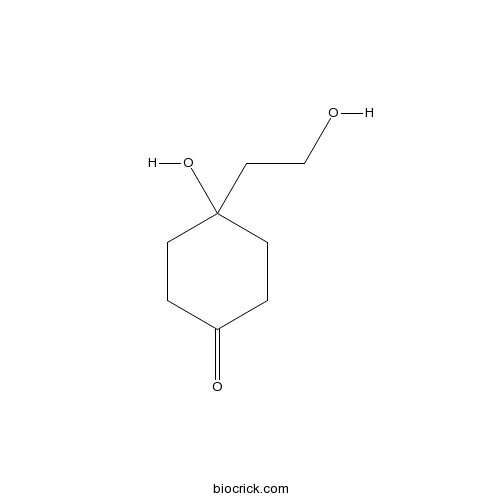Cleroindicin BCAS# 107389-91-3 |

Quality Control & MSDS
3D structure
Package In Stock
Number of papers citing our products

| Cas No. | 107389-91-3 | SDF | Download SDF |
| PubChem ID | 184824 | Appearance | Oil |
| Formula | C8H14O3 | M.Wt | 158.2 |
| Type of Compound | Miscellaneous | Storage | Desiccate at -20°C |
| Solubility | Soluble in Chloroform,Dichloromethane,Ethyl Acetate,DMSO,Acetone,etc. | ||
| Chemical Name | 4-hydroxy-4-(2-hydroxyethyl)cyclohexan-1-one | ||
| SMILES | C1CC(CCC1=O)(CCO)O | ||
| Standard InChIKey | QLSFMYCHPVOSCD-UHFFFAOYSA-N | ||
| Standard InChI | InChI=1S/C8H14O3/c9-6-5-8(11)3-1-7(10)2-4-8/h9,11H,1-6H2 | ||
| General tips | For obtaining a higher solubility , please warm the tube at 37 ℃ and shake it in the ultrasonic bath for a while.Stock solution can be stored below -20℃ for several months. We recommend that you prepare and use the solution on the same day. However, if the test schedule requires, the stock solutions can be prepared in advance, and the stock solution must be sealed and stored below -20℃. In general, the stock solution can be kept for several months. Before use, we recommend that you leave the vial at room temperature for at least an hour before opening it. |
||
| About Packaging | 1. The packaging of the product may be reversed during transportation, cause the high purity compounds to adhere to the neck or cap of the vial.Take the vail out of its packaging and shake gently until the compounds fall to the bottom of the vial. 2. For liquid products, please centrifuge at 500xg to gather the liquid to the bottom of the vial. 3. Try to avoid loss or contamination during the experiment. |
||
| Shipping Condition | Packaging according to customer requirements(5mg, 10mg, 20mg and more). Ship via FedEx, DHL, UPS, EMS or other couriers with RT, or blue ice upon request. | ||
| Description | 1. Cleroindicin B shows weak scavenging action on 2,2-diphenyl-l-picrylhydrazyl and hydroxyl radicals. |

Cleroindicin B Dilution Calculator

Cleroindicin B Molarity Calculator
| 1 mg | 5 mg | 10 mg | 20 mg | 25 mg | |
| 1 mM | 6.3211 mL | 31.6056 mL | 63.2111 mL | 126.4223 mL | 158.0278 mL |
| 5 mM | 1.2642 mL | 6.3211 mL | 12.6422 mL | 25.2845 mL | 31.6056 mL |
| 10 mM | 0.6321 mL | 3.1606 mL | 6.3211 mL | 12.6422 mL | 15.8028 mL |
| 50 mM | 0.1264 mL | 0.6321 mL | 1.2642 mL | 2.5284 mL | 3.1606 mL |
| 100 mM | 0.0632 mL | 0.3161 mL | 0.6321 mL | 1.2642 mL | 1.5803 mL |
| * Note: If you are in the process of experiment, it's necessary to make the dilution ratios of the samples. The dilution data above is only for reference. Normally, it's can get a better solubility within lower of Concentrations. | |||||

Calcutta University

University of Minnesota

University of Maryland School of Medicine

University of Illinois at Chicago

The Ohio State University

University of Zurich

Harvard University

Colorado State University

Auburn University

Yale University

Worcester Polytechnic Institute

Washington State University

Stanford University

University of Leipzig

Universidade da Beira Interior

The Institute of Cancer Research

Heidelberg University

University of Amsterdam

University of Auckland

TsingHua University

The University of Michigan

Miami University

DRURY University

Jilin University

Fudan University

Wuhan University

Sun Yat-sen University

Universite de Paris

Deemed University

Auckland University

The University of Tokyo

Korea University
- LDC000067
Catalog No.:BCC5452
CAS No.:1073485-20-7
- Demethylzeylasteral
Catalog No.:BCN2282
CAS No.:107316-88-1
- Defactinib
Catalog No.:BCC5494
CAS No.:1073154-85-4
- SR-3677
Catalog No.:BCC4302
CAS No.:1072959-67-1
- MLN2238
Catalog No.:BCC2092
CAS No.:1072833-77-2
- Carasinol D
Catalog No.:BCN8228
CAS No.:1072797-66-0
- Baogongteng C
Catalog No.:BCN1873
CAS No.:107259-50-7
- NPPB
Catalog No.:BCC6711
CAS No.:107254-86-4
- 2-[(1S)-2-Formyl-1,3,3-trimethylcyclohexyl]-4-hydroxy-5-propan-2-ylbenzaldehyde
Catalog No.:BCN3584
CAS No.:1072444-55-3
- Cevimeline
Catalog No.:BCC1470
CAS No.:107233-08-9
- Epigoitrin
Catalog No.:BCN6278
CAS No.:1072-93-1
- AT-406 (SM-406)
Catalog No.:BCC1283
CAS No.:1071992-99-8
- Garcinone D
Catalog No.:BCN2526
CAS No.:107390-08-9
- CD 1530
Catalog No.:BCC7406
CAS No.:107430-66-0
- Ginkgolide J
Catalog No.:BCN5939
CAS No.:107438-79-9
- Bisabola-2,10-diene-1,9-dione
Catalog No.:BCN7269
CAS No.:107439-25-8
- Glucagon-like peptide 1 (7-36) amide (human, rat)
Catalog No.:BCC7258
CAS No.:107444-51-9
- Omadacycline tosylate
Catalog No.:BCC5136
CAS No.:1075240-43-5
- Anwulignan
Catalog No.:BCN5362
CAS No.:107534-93-0
- 3'-Hydroxy-3,9-dihydroeucomin
Catalog No.:BCN5875
CAS No.:107585-75-1
- 4-Demethyl-3,9-dihydroeucomin
Catalog No.:BCN5876
CAS No.:107585-77-3
- 4-Hydroxycoumarin
Catalog No.:BCN2561
CAS No.:1076-38-6
- PF 998425
Catalog No.:BCC7811
CAS No.:1076225-27-8
- Dehydroformouregine
Catalog No.:BCN4054
CAS No.:107633-69-2
Biological Activity of Dolichandrone serrulata Flowers and Their Active Components.[Pubmed:26434124]
Nat Prod Commun. 2015 Aug;10(8):1387-90.
Dolichandrone serrulata (DC.) Seem flowers are widely used as vegetables in northern and eastern Thailand. Biological studies of the methanolic extract of these flowers have shown promising antioxidant activity. Biological-guided separation of D. serrulata flowers yielded six compounds, identified as hallerone, protocatechuic acid, rengyolone, Cleroindicin B, ixoside, and isomaltose. This is the first report on hallerone, protocatechuic acid, rengyolone, Cleroindicin B, and isomaltose in D. serrulata. Protocatechuic acid was the most potent scavenger of 2,2-diphenyl-l-picrylhydrazyl and hydroxyl radicals with IC50 values of 25.6 +/- 0.6 and 29.6 +/- 0.4 microM, respectively. Hallerone and rengyolone showed moderate scavenging action on superoxide radicals and inhibited H202 induced reactive oxygen species production in HEK-293 cell. In addition, the other isolated compounds showed weak activity.


